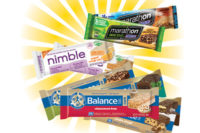Dark Chocolate Coconut, Dark Chocolate Peanut and Dark Chocolate Crunch – despite the decadent confections you’re probably imagining right now, these are the names of the new nutrition bars from Balance Bar’s Dark line.
Also unlike those chocolate bars and truffles you were thinking of, all of these products are actually good for you.
Snack bars have grown to be the largest segment of the snack bar category, grossing $2.1 billion dollars in sales last year, according to SymphonyIRI, a Chicago-based research company.
“Overall, the industry is doing well for itself, drawing in both younger and older consumers,” says Matthew Hudak, a US analyst for Euromonitor International, a strategic research company. “And nutrition bars certainly play a big part in that growth.”
Euromonitor, which accurately determined the nutrition bar’s rise in popularity, also predicts the industry will continue to grow and will reach and overall value of $6.5 billion dollars by 2016.
Health for Everyone
One of the major ways companies insure growth in the snack bar industry is by catering to various demographics. Mars Chocolate North America, manufacturer of Marathon bars and Kudos granola bars, emphasizes this by creating products that appeal and expand beyond the athletic community.
“One of the fastest growing consumer segments are the “daily performers” — everyday people trying to keep active in enjoyable ways,” says Tim Quinn, the company’s vice president of trade development.
Elle Stassen, KIND’s senior director of Communications also agrees that the easier way to appeal to a wider demographic is by removing the label.
“KIND is first and foremost a healthy snack, rather than a diet bar, energy bar or nutrition bar,” Stassen says. “Our product appeals to a very wide array of consumers who are looking for healthy bite that taste good and fills them up.”
However, there are snack bar companies who want their message to be clear, narrow and directly aimed at a specific group of consumers.
“We reach a wide range of demographics, but there’s always a great opportunity to continue to reach targeted groups with specific messages,” says Erin Lifeso, Balance Bar’s senior director of marketing. Lifeso also identifies the company’s target group as 18-24 year olds and 35+ females, who have, “a busy life and need a nutritional boost and lasting energy during their day.”
Protein, Protein, Protein
In addition to increasing their demographic, many companies have been following consumer trends and adding more protein — a substance linked to satiety — to their nutrition bars; a decision that seems to play out well in most cases.
The top five nutritional bars in SymphonyIRI data have some amount of protein in them, and three of the top five have at least 10 grams of the nutrient in them. Additionally, 87% of U.S. consumers identified satiety as an important food attribute for them when choosing products, according to Mintel, a data research firm.
“Companies have been adding anything to up the protein intake and make their products have a higher satiety and to keep consumers fuller longer,” says Hudak. “It’s going to keep driving the industry.”
Nutrition bar companies have been increasing the protein in their product in a variety of ways, from including more of the nutrient in its additive form to adding a layer of Greek yogurt. However, one of the easiest ways for brands to achieve a protein-rich nutrition bar is by adding almonds to their mixture.
According to the Almond Board of California’s data, almonds have the highest amount of protein, fiber, calcium, vitamin E, riboflavin and niacin of any tree nut.
“Almonds are a multi-tasking ingredient. They’re nutritious, great-tasting, adaptable and easy to use in a wide range of formulas and applications,” says Molly Spence, director of North American marketing for the Almond Board of California.
In addition to being good for consumers’ health and satiety, Spence says almonds are an easily accessible ingredient for North American manufacturers.
“Eighty-four percent of the world’s almonds and 100 percent of the United States’ almonds come from California,” she says. “They also come in a variety of forms; whole, sliced, even as a butter.”
As one of the first ingredients in each of its Nut & Spice bars, KIND prefers to use almonds in its chopped form. Balance Bar, on the other hand, uses almonds in a minced form and combines the tree nut with chocolate.
Keeping it Healthy
While the nutrition bar market is poised to continue expansion, no industry is completely safe. Hudak says eventually, every brand will be offering products with a similar variation of flavors and dietary restrictions — which tightens the competition and makes factors more important.
“At that time, healthiness will become the major factor in determining which bar consumers will buy,” he says.
While it is not currently the dominating factor, many companies are taking this time to improve the healthiness of their nutrition bars, even those that based their products on strict dietary principles.
“At KIND, we practice something we call the ‘AND’ philosophy, which means creating healthy snacks that are both nutritionally superior AND delicious — never sacrificing one quality in favor of the other,” Stassen says.
The brand’s newest line, Nuts & Spices, follow this principle exactly. Each of the four bars in the line meet the recommended daily protein and fiber needs without using artificial sweeteners or sugar alcohols.
Equally strict in their product creation is Balance Bar, which follows the 40-30-30 nutrition principle where 40% of calories come from carbohydrates, 30% from protein and 30% from dietary fat.
“High-quality nutrition that taste great is a standard for Balance Bar,” Lifeso says.
Although Hudak predicts that flavors will tighten the market, there are other groups who believe the market is already closed, particularly for confectionery companies. Rabobank Group, a global financial services provider, released a report in 2012 claiming few confectionery companies found success in extending their candy brands into the snack bar space.
“Candy is perhaps too much of a challenge to the wholesome, active image of the snack bar, particularly energy bars,” says Nicholas Fereday, author of the report and Rabobank analyst. “Snack bars are perceived as contributing to better health and, up until now, have been less associated with the empty calories of soft drinks and candy."
And the data supports Fereday’s statement. In the snack bar category, only Mars was listed in any of SymphonyIRI’s Top 20 data.
However, this is where snack bars like Kudos and Marathon have succeeded. By ridding itself of the “nutrition bar” label, not only does the product move away from the intensity of the category, it opens itself up to a wider demographic. Those “daily performers” who might be intimidated by terms like, “low glycemic diet” and “carb conscious”.
At the end of the day, consumers want tasty snacks bars that won’t completely put their diets, and if extra protein or fiber comes with said bar, then most of them will be on board.







